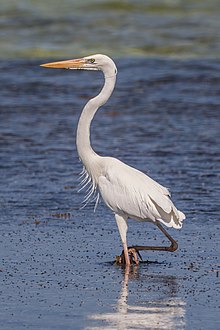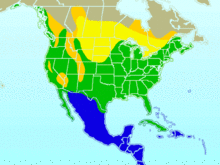From Wikipedia, the free encyclopedia
The great blue heron (Ardea herodias) is a large wading bird in the heron family Ardeidae, common near the shores of open water and in wetlands over most of North America and Central America, as well as the Caribbean and the Galápagos Islands. It is a rare vagrant to coastal Spain, the Azores, and areas of far southern Europe. An all-white population found only in the Caribbean and Florida was once treated as a separate species and known as the great white heron...
| Great blue heron | |
|---|---|
 | |
| Dark form | |
 | |
| White form, A. h. occidentalis both in Cuba | |
 | |
| Breeding range Year-round range Wintering range Present during migration |
...
Thus, great blue herons are roughly twice as heavy as great egrets (Ardea alba), although only slightly taller than them, but they can weigh about half as much as a large goliath heron.[12]
Notable features of great blue herons include slaty (gray with a slight azure blue) flight feathers, red-brown thighs, and a paired red-brown and black stripe up the flanks; the neck is rusty-gray, with black and white streaking down the front; the head is paler, with a nearly white face, and a pair of black or slate plumes runs from just above the eye to the back of the head. The feathers on the lower neck are long and plume-like; it also has plumes on the lower back at the start of the breeding season. The bill is dull yellowish, becoming orange briefly at the start of the breeding season, and the lower legs are gray, also becoming orangey at the start of the breeding season. Immature birds are duller in color, with a dull blackish-gray crown, and the flank pattern is only weakly defined; they have no plumes, and the bill is dull gray-yellow.[
...
The subspecies differ only slightly in size and plumage tone, with the exception of subspecies A. h. occidentalis, which also has a distinct white morph, known as the great white heron (not to be confused with the great egret, for which "great white heron" was once a common name). It is found only in south Florida and some parts of the Caribbean. The great white heron differs from other great blues in bill morphology, head plume length, and in having a total lack of pigment in its plumage. It averages somewhat larger than the sympatric race A. h. wardi and may be the largest race in the species. In a survey of A. h. occidentalis in Florida, males were found to average 3.02 kg (6.7 lb) and females average 2.57 kg (5.7 lb), with a range for both sexes of 2 to 3.39 kg (4.4 to 7.5 lb).[5]This is mainly found near salt water, and was long thought to be a separate species. Birds intermediate between the normal morph and the white morph are known as Würdemann's heron; these birds resemble a "normal" great blue with a white head.
...
The great blue heron is found throughout most of North America, as far north as Alaska and the southern Canadian provinces in the summer months. In winter, the range extends south through Florida, Mexico, and the Caribbean to South America. Birds east of the Rocky Mountains in the northern part of their range are migratory and winter in the coastal areas of the southern United States, Central America or northern South America. From the southern United States southwards, and on the lower Pacific coast, they are year-round residents.[4] However, their hardiness is such that individuals often remain through cold northern winters, as well, so long as fish-bearing waters remain unfrozen (which may be the case only in flowing water such as streams, creeks, and rivers).
The great blue heron can adapt to almost any wetland habitat in its range. It may be found in numbers in fresh and saltwater marshes, mangrove swamps, flooded meadows, lake edges, or shorelines. It is quite adaptable and may be seen in heavily developed areas as long as they hold bodies of fish-bearing water.
Great blue herons rarely venture far from bodies of water, but are occasionally seen flying over upland areas. They usually nest in trees or bushes near water's edge, often on islands (which minimizes the potential for predation) or partially isolated spots.[19]
It has been recorded as a vagrant in England,
...


No comments:
Post a Comment